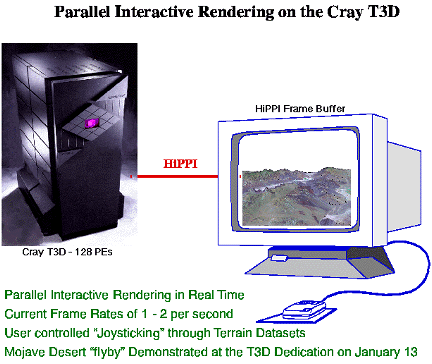
Objective: To evaluate the new Cray hardware and software in support to expanding the number of applications in the Massively Parallel Processing (MPP) arena.
Approach: On January 3, 1994, a Cray T3D MPP system was delivered to JPL. This system was procured under a collaborative agreement between Caltech/JPL and Cray Research, Inc.(CRI). NASA offices sponsoring this system are the Office of Space Sciences, Mission to Plant Earth and Aeronautics. Caltech campus/ JPL and CRI have defined a partnership under the Parallel Applications Technology Program (PATP) to evaluate the new Cray T3D. CRI takes advantage of previous Caltech campus/JPL MPP experience to help rapidly increase the number of applications running on the Cray T3D. Caltech campus/JPL benefits from PATP through early access to the Cray T3D hardware and software on a cost-shared basis and by having additional on-site CRI technical applications experts. Approximately 25 projects have been identified at Caltech campus/JPL as official collaborations in the PATP. The range of the identified projects spans visualization, ocean/atmospheric modeling, spacecraft design and electromagnetics. In addition, PATP collaborators plan to develop software tools and documentation for the MPP environment which will ease the use of these systems. The Cray T3D system consists of 256 processing elements (PEs) with 16 megabytes of memory per PE for a total of 4 gigabytes of memory. Each processor is capable of per-forming at 150 megaflops for a peak system speed of 38 gigaflops.

Accomplishments: One of the first JPL projects to run on the new Cray T3D system was the code to do remote interactive exploration of large scientific datasets. JPL developed a ray-identification algorithm for parallel 3-D perspective rendering which can optionally control the viewpoint and display results over high bandwidth networks. The algorithmic approach was specifically designed to be scalable to very large datasets (multi-gigabyte) and large parallel machines (hundreds of nodes) with good production efficiency. Large MARS and US datasets have been used to demonstrate this code. Other Caltech campus/JPL applications which have successfully run on the Cray T3D include electromagnetic simulations for the design of communications antennas, studying the dynamics of chemical reactions, examining the flow of space plasmas, and computational fluid dynamics.
Significance: Caltech campus/JPL will provide feedback from its experiences using the Cray T3D to CRI to enhance its hardware and software and thus contribute to maintaining US leadership in supercomputing. The applications running on the Cray T3D will help address the grand challenges of Earth and Space Sciences in the analysis of the enormous sets of data from NASA's earth and planetary missions.
Status/Plans: The amount of local memory per PE is currently 16 megabytes. The memory will be upgraded to 64 megabytes per PE for a total of 16 gigabytes of memory. The memory upgrade will be an on-site replacement of memory boards within the Cray T3D system. With the additional memory per PE, the input and output of data will be reduced which will result in near real-time analysis of datasets. Currently defined collaboration projects will continue to enhance their applications running on the Cray T3D and new collaboration projects will be defined. Caltech campus/JPL will provide feed back to CRI to enhance its current and future MPP systems.
Point of Contact:
 Return to the PREVIOUS PAGE
Return to the PREVIOUS PAGE